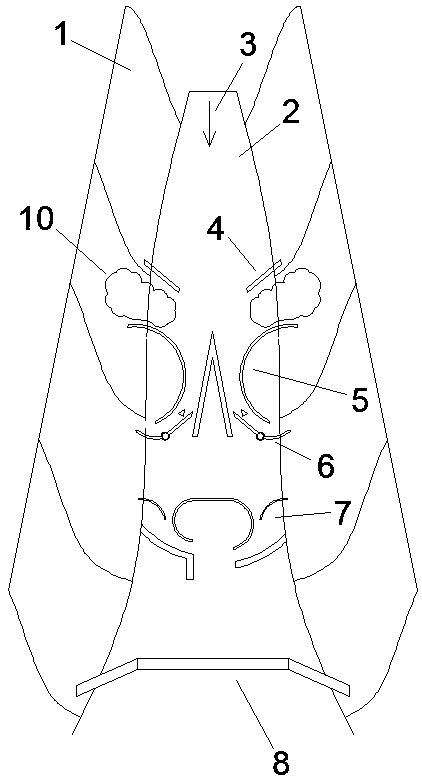Movable shunting blocking system for debris flow prevention and control
A mud-rock flow and mobile technology, which is applied in dikes, water conservancy projects, sea area engineering, etc., can solve the problems of unsatisfactory mud-rock flow effects, achieve strong anti-geological disaster ability, reduce impact force and destructiveness, and reduce contact area.
- Summary
- Abstract
- Description
- Claims
- Application Information
AI Technical Summary
Benefits of technology
Problems solved by technology
Method used
Image
Examples
Embodiment 1
[0044] Such as figure 1 As shown, a movable diversion barrier system for debris flow prevention and control, the barrier system is set in the debris flow channel 2 formed between the highlands 1 on both sides, according to the flow direction 3 of the debris flow in the debris flow channel 2, the barrier system It includes a movable diverter dam, an energy dissipation retaining dam 7 and an intercepting dam 8 arranged in sequence, wherein the movable diverter dam includes a silting diversion dam 5 and two movable diversion mechanisms 6, and the silting diversion dam 5 Divide the debris flow into two strands, and then under the guidance of two movable diversion mechanisms 6, carry out secondary diversion and stop silting on the divided debris flow; the energy dissipation retaining dam 7 divides the debris flow into two strands after blocking, and The two streams of debris flows diverted to form convective flows with intersecting flow directions, and then hedge to form turbulent ...
Embodiment 2
[0048] This embodiment is an improvement made on the basis of Embodiment 1, its basic structure is the same as that of Embodiment 1, and the improvements are as follows: Figure 2-4 As shown, the silting stop and diversion dam 5 includes first arc-shaped dam bodies 501 symmetrically arranged on both sides of the debris flow channel 2, and the upstream ends of the two first arc-shaped dam bodies 501 cross the two ends of the debris flow channel 2 respectively. The sides are connected to the highlands 1 on both sides, and there is a gap between the downstream end and the two sides of the debris flow channel 2, so that the backwater surface of the two first arc-shaped dam bodies 501 cooperates with the highlands 1 on both sides to form a direction facing downstream. The first silting zone 505 of the opening; a hyperbolic drainage channel 502 is formed between the two first arc-shaped dam bodies 501, and a triangular diversion dam 503 is arranged in the drainage channel 502, and th...
Embodiment 3
[0053] This embodiment is an improvement made on the basis of Embodiment 2, its basic structure is the same as that of Embodiment 2, and the improvements are as follows: Figure 2-4 As shown in and 6-7, the side of the first diversion plate 602 facing the first arc-shaped dam body 501 on this side is provided with a limit pile 603 to limit its deflection to the side of the diversion dam 503, and the limit pile 603 is triangular cement pile, and one of the sharp corners of its triangle faces the direction of the debris flow. The bottoms of the first diversion plate 602 and the second diversion plate 604 are provided with several support columns along their length direction, and the bottom end of each support column has a spherical support body 605 supported on the ground; the spherical support body 605 is actually On the top is a sphere supported by cement concrete, so that the contact area with the ground is small, and it can be rotated conveniently when impacted by debris flo...
PUM
 Login to View More
Login to View More Abstract
Description
Claims
Application Information
 Login to View More
Login to View More - R&D
- Intellectual Property
- Life Sciences
- Materials
- Tech Scout
- Unparalleled Data Quality
- Higher Quality Content
- 60% Fewer Hallucinations
Browse by: Latest US Patents, China's latest patents, Technical Efficacy Thesaurus, Application Domain, Technology Topic, Popular Technical Reports.
© 2025 PatSnap. All rights reserved.Legal|Privacy policy|Modern Slavery Act Transparency Statement|Sitemap|About US| Contact US: help@patsnap.com



